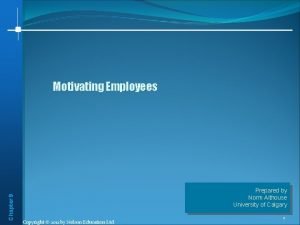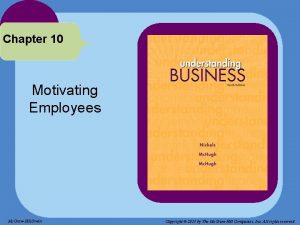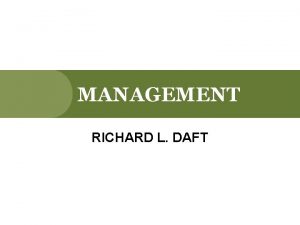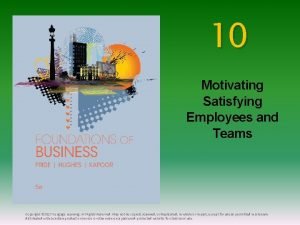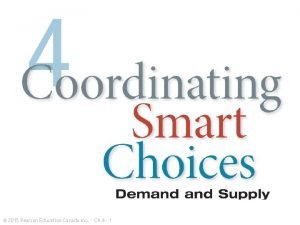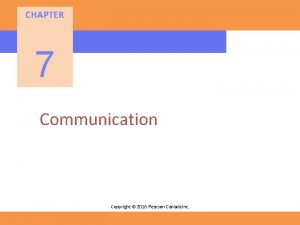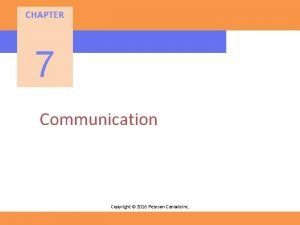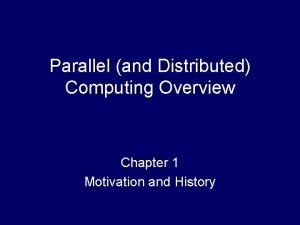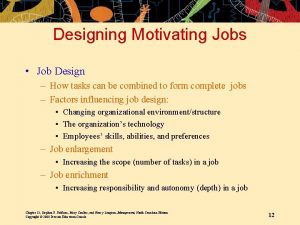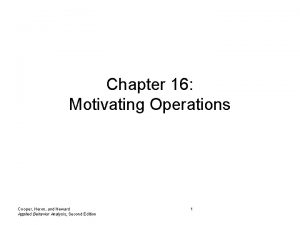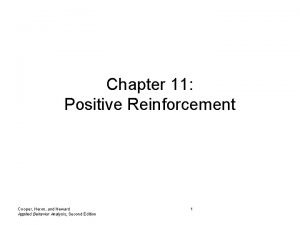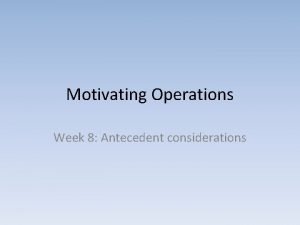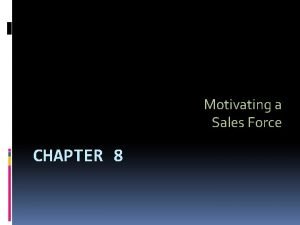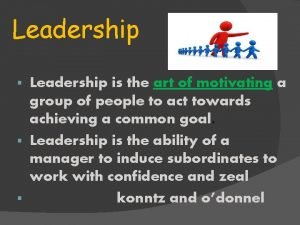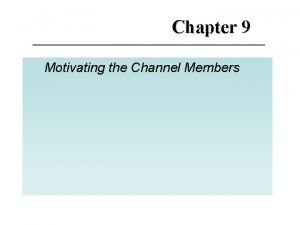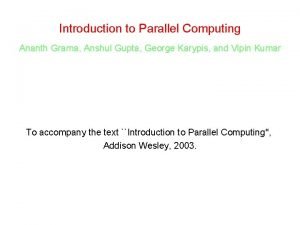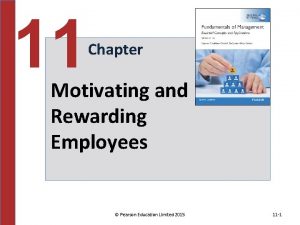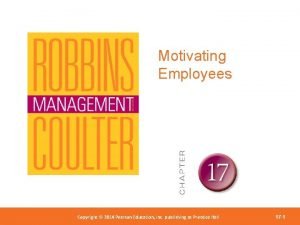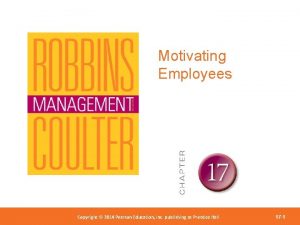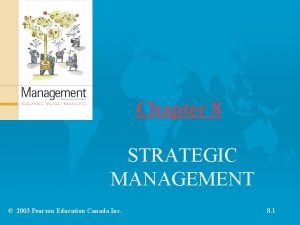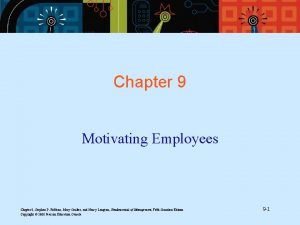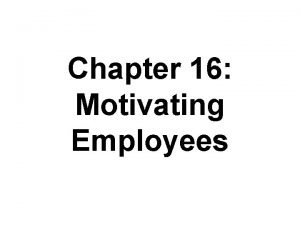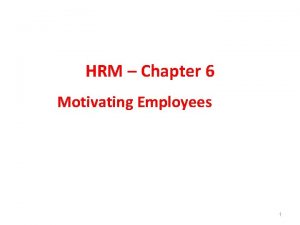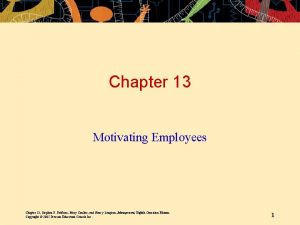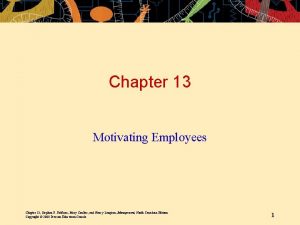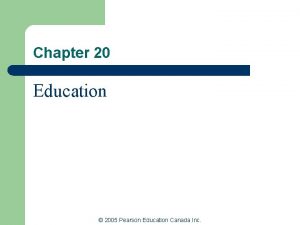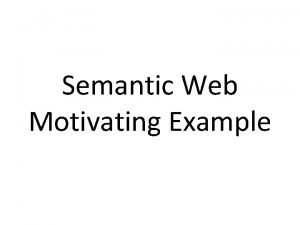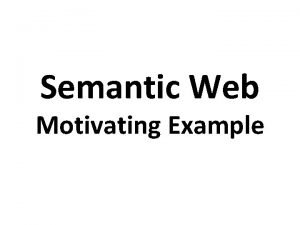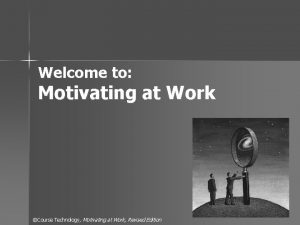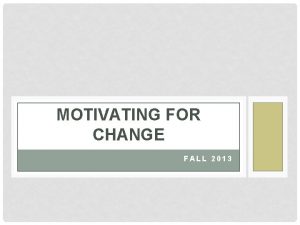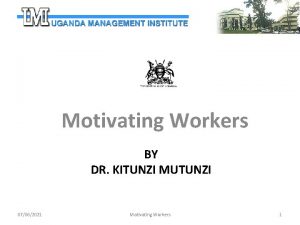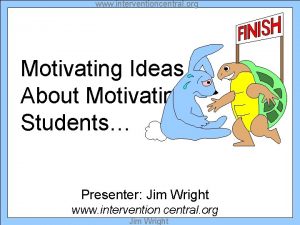Chapter 16 MOTIVATING EMPLOYEES 2003 Pearson Education Canada



































- Slides: 35

Chapter 16 MOTIVATING EMPLOYEES © 2003 Pearson Education Canada Inc. 16. 1

LEARNING OBJECTIVES • You should be able to: – Define the motivation process – Describe three early motivation theories – Explain how goals motivate people – Differentiate reinforcement theory from goalsetting theory – Identify ways to design motivating jobs © 2003 Pearson Education Canada Inc. 16. 2

LEARNING OBJECTIVES (continued) • You should be able to: (continued) – Describe the motivational implications of equity theory – Explain the key relationships in expectancy theory – Describe current motivation issues facing managers – Identify management practices that are likely to lead to more motivated employees © 2003 Pearson Education Canada Inc. 16. 3

WHAT IS MOTIVATION? • Motivation – The willingness to exert high levels of effort to reach organizational goals, conditioned by the effort’s ability to satisfy some individual need – effort - a measure of intensity or drive • goals - effort should be directed toward, and consistent with, organizational goals – Need - an internal state that makes certain outcomes appear attractive • unsatisfied needs create tensions that stimulate drives • drives lead to search behavior © 2003 Pearson Education Canada Inc. 16. 4

THE MOTIVATION PROCESS (Exhibit 16. 1) Unsatisfied Need Tension Drives © 2003 Pearson Education Canada Inc. Search Behavior Satisfied Need Reduction of Tension 16. 5

EARLY THEORIES OF MOTIVATION • Maslow’s Hierarchy of Needs Theory – – Lower-order needs - largely satisfied externally • physiological - food, drink, shelter, sexual satisfaction • safety - security and protection from physical and emotional harm – assurance that physiological needs will be satisfied Higher-order needs - largely satisfied internally • social - affection, belongingness, acceptance • esteem - internal factors like self-respect, autonomy – external factors like status, recognition, attention • self-actualization - achieving one’s potential © 2003 Pearson Education Canada Inc. 16. 6

MASLOW’S HIERARCHY OF NEEDS (Exhibit 16. 2) Self. Actualization Esteem Social Safety Physiological © 2003 Pearson Education Canada Inc. 16. 7

EARLY THEORIES OF MOTIVATION (continued) • Mc. Gregor’s Theory X and Theory Y – – Theory X - assumes that workers have little ambition, dislike work, want to avoid responsibility, and need to be closely controlled Theory Y - assumes that workers can exercise selfdirection, accept and actually seek out responsibility, and consider work to be a natural activity No evidence that either set of assumptions is valid No evidence that managing on the basis of theory Y makes employees more motivated © 2003 Pearson Education Canada Inc. 16. 8

EARLY THEORIES OF MOTIVATION (continued) • Herzberg’s Motivation-Hygiene Theory – – – Intrinsic characteristics consistently related to job satisfaction • Motivator factors increase job satisfaction and motivation Extrinsic characteristics consistently related to job dissatisfaction • Hygiene factors don’t motivate employees Proposed dual continua for satisfaction and dissatisfaction Theory enjoyed wide popularity Theory was roundly criticized © 2003 Pearson Education Canada Inc. 16. 9

HERZBERG’S MOTIVATIONHYGIENE THEORY (Exhibit 16. 3) © 2003 Pearson Education Canada Inc. 16. 10

CONTRASTING VIEWS OF SATISFACTION-DISSATISFACTION (Exhibit 16. 4) Traditional View Satisfaction Dissatisfaction Herzberg’s View Motivators Satisfaction No Satisfaction © 2003 Pearson Education Canada Inc. Hygienes No Dissatisfaction 16. 11

CONTEMPORARY THEORIES OF MOTIVATION • Three-Needs Theory - Mc. Clelland – – Need for achievement (nach) - drive to excel, to achieve in relation to a set of standards, and to strive to succeed Need for power (npow) - need to make others behave in a way that they would not have behaved otherwise Need for affiliation (naff) - desire for friendly and close interpersonal relationships Best managers tend to be high in the need for power and low in the need for affiliation © 2003 Pearson Education Canada Inc. 16. 12

CONTEMPORARY THEORIES OF MOTIVATION (continued) • Goal-Setting Theory – – – Intention to work toward a goal is a major source of job motivation Specific goals increase performance When accepted, lead to higher performance Participation in goal setting is useful Feedback is useful • helps identify discrepancies between what has been accomplished and what needs to be done • self-generated feedback is a powerful motivator • goal commitment - theory presupposes that individual is determined to accomplish the goal © 2003 Pearson Education Canada Inc. 16. 13

CONTEMPORARY THEORIES OF MOTIVATION (continued) • Goal-Setting Theory (continued) – Contingencies in goal-setting theory • goal commitment - theory presupposes that individual is determined to accomplish the goal • self-efficacy - an individual’s belief that s/he is capable of performing a task – higher self-efficacy, greater motivation to attain goals • national culture - theory is culture bound – main ideas align with North American cultures – goal setting may not lead to higher performance in other cultures © 2003 Pearson Education Canada Inc. 16. 14

GOAL-SETTING THEORY (Exhibit 16. 5) © 2003 Pearson Education Canada Inc. 16. 15

CONTEMPORARY THEORIES OF MOTIVATION (continued) • Reinforcement Theory – Behaviour is solely a function of its consequences • Behaviour is externally caused – Reinforcers - consequences that, when given immediately following a behaviour, affect the probability that the behaviour will be repeated • managers can influence employees’ behaviour by reinforcing actions deemed desirable • emphasis in on positive reinforcement, not punishment © 2003 Pearson Education Canada Inc. 16. 16

CONTEMPORARY THEORIES OF MOTIVATION (continued) • Designing Motivating Jobs – – Job Design - the way tasks are combined to form complete jobs Job Enlargement - horizontal expansion of job • job scope - the number of different tasks required in a job and the frequency with which these tasks are repeated • provides few challenges, little meaning to workers’ activities • only addresses the lack of variety in specialized jobs © 2003 Pearson Education Canada Inc. 16. 17

CONTEMPORARY THEORIES OF MOTIVATION (continued) • Designing Motivating Jobs (continued) – Job Enrichment - vertical expansion of job • job depth - degree of control employees have over their work • research evidence has been inconclusive about the effect of job enrichment on performance © 2003 Pearson Education Canada Inc. 16. 18

CONTEMPORARY THEORIES OF MOTIVATION (continued) • Designing Motivating Jobs (continued) – Job Characteristics Model (JCM) - conceptual framework for analyzing jobs • jobs described in terms of five core characteristics – skill variety - degree to which job requires a variety of activities – task identity - degree to which job requires completion of an identifiable piece of work – task significance - degree to which job has substantial impact on the lives of other people – these three characteristics create meaningful work © 2003 Pearson Education Canada Inc. 16. 19

CONTEMPORARY THEORIES OF MOTIVATION (continued) • Designing Motivating Jobs (continued) – Job Characteristics Model (JCM) (continued) • jobs described in terms of five core characteristics (continued) – autonomy - degree to which job provides substantial freedom, independence, and discretion in performing the work – feedback - degree to which carrying out the job results in receiving clear information about the effectiveness with which it has been performed © 2003 Pearson Education Canada Inc. 16. 20

JOB CHARACTERISTICS MODEL(Exhibit 16. 6) Core Job Dimension s Skill Variety Task Identity Task Significance Autonomy Feedback Critical Psychological States Experienced meaningfulness of the work Experienced responsibility for outcomes of work Knowledge of the actual results of the work Strength of Employee Growth Need © 2003 Pearson Education Canada Inc. Personal and Work Outcomes High Internal Work Motivation High-Quality Work Performance High Satisfaction with the Work Low Absenteeism and Turnover 16. 21

GUIDELINES FOR JOB REDESIGN (Exhibit 16. 7) Suggested Actions Core Job Dimensions Combining Tasks Skill Variety Forming Natural Work Units Task Identity Forming Natural Work Units Task Significance Load Vertically Autonomy Opening Feedback Channels Feedback © 2003 Pearson Education Canada Inc. 16. 22

CONTEMPORARY THEORIES OF MOTIVATION (continued) • Equity Theory – – – Proposes that employees perceive what they get from a job (outcomes) in relation to what they put into it (inputs) Input/outcome ratio compared with the ratios of relevant others Referent (relevant other) may be: • other - individuals with similar jobs • a system - includes organizational pay policies and administrative systems • self - past personal experiences and contacts © 2003 Pearson Education Canada Inc. 16. 23

EQUITY THEORY (Exhibit 16. 8) © 2003 Pearson Education Canada Inc. 16. 24

CONTEMPORARY THEORIES OF MOTIVATION (continued) • Equity Theory (continued) – When inequities are perceived, employees act to correct the situation • distort either their own or others’ inputs or outputs • behave in a way to induce others to change their inputs or outputs • behave in a way to change their own inputs or outputs • choose a different comparison person • quit their jobs – Theory leaves some issues unclear © 2003 Pearson Education Canada Inc. 16. 25

CONTEMPORARY THEORIES OF MOTIVATION (continued) • Expectancy Theory – – Theory states that an individual tends to act in a certain way based on the expectation that the act will be followed by a given outcome and on the attractiveness of that outcome to the individual Expectancy (effort-performance linkage) - perceived probability that exerting a given amount of effort will lead to a certain level of performance Instrumentality (performance-reward linkage) - strength of belief that performing at a particular level is instrumental in attaining an outcome Valence - attractiveness or importance of the potential outcome © 2003 Pearson Education Canada Inc. 16. 26

SIMPLIFIED EXPECTANCY MODEL (Exhibit 16. 9) Individual Effort A Individual Performance B Organizational Rewards C Individual Goals A = Effort-performance linkage B = Performance-reward linkage C = Attractiveness © 2003 Pearson Education Canada Inc. 16. 27

CONTEMPORARY THEORIES OF MOTIVATION (continued) • Expectancy Theory (continued) – – Theory emphasizes rewards No universal principle for explaining what motivates individuals • managers must understand why employees view certain outcomes as attractive or unattractive – Most comprehensive and widely accepted explanation of employee motivation © 2003 Pearson Education Canada Inc. 16. 28

INTEGRATING CONTEMPORARY THEORIES OF MOTIVATION (Exhibit 16. 10) © 2003 Pearson Education Canada Inc. 16. 29

CURRENT ISSUES IN MOTIVATION • Motivating a Diverse Workforce – Flexibility is the key to motivating a diverse workforce • Diverse array of rewards necessary to satisfy diverse personal needs and goals – Flexible Working Schedule • compressed workweek - employees work longer hours per day but fewer days per week © 2003 Pearson Education Canada Inc. 16. 30

CURRENT ISSUES IN MOTIVATION (continued) • Motivating a Diverse Workforce (continued) – – – Flexible work hours (flextime) - employees required to work a specific number of hours a week but are free to vary those hours within certain limits Job sharing - two or more people split a full-time job Telecommuting - employees work at home and are linked to the workplace by computer and modem © 2003 Pearson Education Canada Inc. 16. 31

CURRENT ISSUES IN MOTIVATION (continued) • Motivating a Diverse Workforce (continued) – Cultural Differences in Motivation • motivation theories developed in the U. S. and validated with American workers • may be some cross-cultural consistencies • Pay-for-Performance – – – instead of paying for time on the job, pay is adjusted to reflect some performance measure compatible with expectancy theory programs are gaining in popularity © 2003 Pearson Education Canada Inc. 16. 32

CURRENT ISSUES IN MOTIVATION (continued) • Open-Book Management – – Involve employees in workplace decisions by opening up the financial statements Workers treated as business partners Get workers to think like an owner May also provide bonuses based on profit improvements • Motivating the “new workforce” – Motivating professionals - professionals tend to derive intrinsic satisfaction from their work and receive high pay © 2003 Pearson Education Canada Inc. 16. 33

CURRENT ISSUES IN MOTIVATION (continued) • Motivating the “new workforce” – Motivating Contingent Workers - part-time, contract, or temporary workers • less security and stability than permanent employees • display little identification or commitment to their employers • hard to motivate contingent workers • repercussions of mixing permanent and contingent workers when pay differentials are significant – Motivating Low-Skilled, Minimum-Wage Employees • difficult challenge to keep performance levels high • employee recognition programs • in service industries, empower front-line employees to address customers’ problems © 2003 Pearson Education Canada Inc. 16. 34

FROM THEORY TO PRACTICE Recognize individual differences Don’t ignore money Check the system for equity Link rewards to performance © 2003 Pearson Education Canada Inc. Match people to jobs Suggestions for Motivating Employees Use goals Ensure that goals are perceived as attainable Individualize rewards 16. 35
 Motivating and satisfying employees and teams
Motivating and satisfying employees and teams Chapter 10 motivating and satisfying employees and teams
Chapter 10 motivating and satisfying employees and teams Norm althouse
Norm althouse Chapter 10 motivating employees
Chapter 10 motivating employees Chapter 10 motivating employees
Chapter 10 motivating employees Herzberg’s two-factor theory
Herzberg’s two-factor theory Motivating employees without money
Motivating employees without money Motivating and satisfying employees and teams
Motivating and satisfying employees and teams Motivating and satisfying employees and teams
Motivating and satisfying employees and teams Copyright
Copyright Copyright 2003 pearson education inc
Copyright 2003 pearson education inc Pearson education canada
Pearson education canada Pearson education, inc. publishing as prentice hall
Pearson education, inc. publishing as prentice hall Pearson education inc publishing as pearson prentice hall
Pearson education inc publishing as pearson prentice hall Pearson education inc publishing as pearson prentice hall
Pearson education inc publishing as pearson prentice hall Pearson education inc. 2012
Pearson education inc. 2012 2008 pearson prentice hall inc
2008 pearson prentice hall inc Pearson publishing canada
Pearson publishing canada 2016 pearson education inc
2016 pearson education inc Pearson canada inc.
Pearson canada inc. Pearson vue president
Pearson vue president Stress management for life 5th edition
Stress management for life 5th edition Motivating parallelism
Motivating parallelism How to motivate esl students
How to motivate esl students Designing motivating jobs adalah
Designing motivating jobs adalah Cmo-r aba
Cmo-r aba Automatic reinforcement aba definition
Automatic reinforcement aba definition Motivating operations definition
Motivating operations definition Motivating sales force
Motivating sales force Exploitative authoritative example
Exploitative authoritative example Motivating channel members
Motivating channel members Staffing and directing in management
Staffing and directing in management Motivating software engineers
Motivating software engineers Introduction to parallel computing ananth grama ppt
Introduction to parallel computing ananth grama ppt What was john cabot motivation
What was john cabot motivation Motivating people for total quality
Motivating people for total quality


